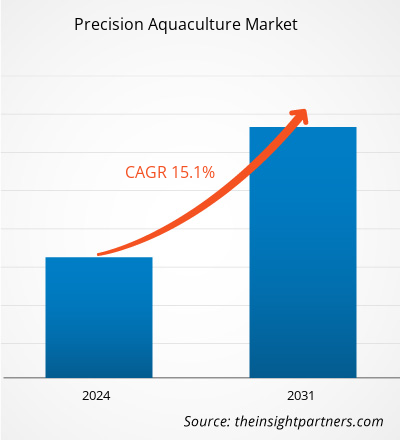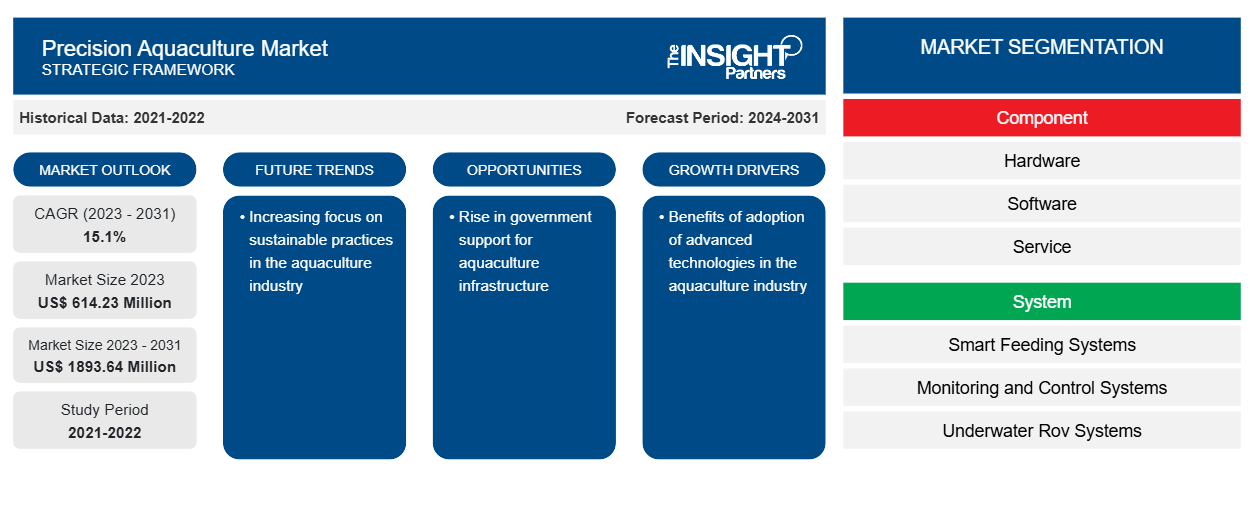정밀 양식 시장 규모는 2023년 6억 1,423만 달러에서 2031년까지 1,893.64만 달러로 성장할 것으로 예상됩니다. 이 시장은 2023~2031년 동안 15.1%의 CAGR을 기록할 것으로 예상됩니다. 양식 인프라에 대한 투자 증가와 양식 산업에서 IoT 솔루션 채택 급증은 시장의 주요 추세로 남을 가능성이 높습니다.
정밀 양식 시장 분석
양식업에서 AI, IoT, ROV 도입이 증가하는 것은 시장 성장을 견인하는 주요 요인 중 하나입니다. 양식 인프라 개발에 대한 정부의 집중과 투자가 증가하면서 시장 성장이 촉진되었습니다. 정밀 양식 기술이 지속 가능한 해산물 생산에 기여하고 수산물에 대한 글로벌 수요를 충족시키면서 시장 성장이 더욱 촉진되었습니다.
정밀 양식 시장 개요
양식업은 농장을 현대화하고 데이터 기반 의사 결정을 내리기 위해 사물 인터넷(IoT) 장치의 배치를 광범위하게 경험하고 있습니다. 정밀 양식업은 해양 환경에서 상호 연결된 센서와 소프트웨어를 사용하여 양식장 운영을 모니터링, 분석, 해석하고 의사 결정 지원을 제공합니다. 데이터 기반 양식업 시스템은 양식업의 운영자가 생산성을 높이는 데 도움이 됩니다.
귀하의 요구 사항에 맞게 이 보고서를 사용자 정의하세요
이 보고서의 일부 또는 국가 수준 분석, Excel 데이터 팩을 포함하여 모든 보고서에 대한 사용자 정의를 무료로 받을 수 있으며 신생 기업 및 대학을 위한 훌륭한 혜택과 할인 혜택을 이용할 수 있습니다.
-
이 보고서의 주요 시장 동향을 알아보세요.이 무료 샘플에는 시장 동향부터 추정 및 예측까지 다양한 데이터 분석이 포함됩니다.
정밀 양식 시장 동인 및 기회
수산양식 산업에서 시장을 선호하기 위한 첨단 기술 도입의 이점
양식업은 사료 및 에너지 비용 증가, 환경 위협, 생산 비효율성 등과 같은 과제를 겪고 있습니다. 이러한 과제를 극복하기 위해 이 산업은 센서, 카메라, 인공 지능, 클라우드 기술 및 기타 여러 솔루션을 사용하여 데이터를 기반으로 전례 없는 통찰력을 수행하고 있으며, 이는 정밀 양식업 시장의 성장으로 이어집니다. 또한 시장 참여자는 양식업 시장 참여자에게 솔루션을 제공하고 있습니다. 예를 들어, Innovasea의 정밀 양식업 기술은 양식업 운영자가 신뢰할 수 있는 실시간 데이터를 기반으로 운영을 면밀히 모니터링, 관리 및 제어할 수 있도록 지원합니다. 운영자가 수익을 늘리고 지속 가능성을 높이기 위해 더 나은 의사 결정을 내리는 데 도움이 됩니다.
양식업 인프라에 대한 정부 지원 증가
스마트 낚시의 증가 추세와 해산물 무역의 성장은 양식 인프라 개발에 필요한 제품에 대한 수요를 확대하고 있습니다. 전 세계적으로 식품 소비 패턴의 변화도 이 산업의 확장과 다각화에 기여하고 있습니다. 게다가 소매 산업의 성장과 수많은 채널을 통한 양식 제품의 쉬운 가용성은 이러한 제품의 판매를 촉진합니다. 노르웨이, 중국, 인도, 인도네시아와 같은 다양한 주요 국가에서 양식의 활발하고 지속적인 성장은 글로벌 정밀 양식 시장을 주도하고 있습니다.
정밀 양식 시장 보고서 세분화 분석
정밀 양식업 시장 분석에 기여한 주요 세그먼트는 구성 요소, 시스템 및 응용 프로그램입니다.
- 구성 요소를 기준으로 정밀 양식 시장은 하드웨어, 소프트웨어, 서비스로 구분됩니다. 하드웨어 부문은 2023년에 시장에서 가장 큰 점유율을 차지했습니다.
- 시스템별로 시장은 스마트 피딩 시스템, 모니터링 및 제어 시스템, 수중 Rov 시스템 등으로 세분화됩니다. 스마트 피딩 시스템은 2023년에 시장에서 상당한 점유율을 차지했습니다.
- 응용 프로그램별로 시장은 사기 탐지 및 예방, 거버넌스 위험 및 규정 준수(GRC), 고객 경험 관리, 예측 유지 관리, 공급망 관리, 위협 인텔리전스 등으로 세분화됩니다. 고객 경험 관리가 2023년에 시장에서 상당한 점유율을 차지했습니다.
지역별 정밀 양식 시장 점유율 분석
정밀 양식업 시장 보고서의 지리적 범위는 주로 북미, 아시아 태평양, 유럽, 중동 및 아프리카, 남미 및 중부 아메리카의 5개 지역으로 나뉩니다.
유럽은 예측 기간 동안 상당한 CAGR을 유지할 것으로 예상됩니다. 이 지역의 디지털화 증가와 고급 데이터 분석 기술에 대한 수요 증가가 시장 성장을 주도하고 있습니다. 또한, 양식 산업을 육성하기 위한 정부 기금이 시장을 주도하고 있습니다. 예를 들어, EU Horizon 2020 Fund는 유럽에서 지속 가능한 양식 강화를 목표로 합니다. EU Horizon 2020 Fund에서 자금을 지원하는 GAIN 프로젝트는 정밀 양식에 초점을 맞춥니다.
정밀 양식 시장 지역 통찰력
Insight Partners의 분석가들은 예측 기간 동안 정밀 양식 시장에 영향을 미치는 지역적 추세와 요인을 철저히 설명했습니다. 이 섹션에서는 북미, 유럽, 아시아 태평양, 중동 및 아프리카, 남미 및 중미의 정밀 양식 시장 세그먼트와 지리에 대해서도 설명합니다.

- 정밀 양식 시장을 위한 지역별 특정 데이터 얻기
정밀 양식 시장 보고서 범위
| 보고서 속성 | 세부 |
|---|---|
| 2023년 시장 규모 | 6억 1,423만 달러 |
| 2031년까지 시장 규모 | 18억 9,364만 달러 |
| 글로벌 CAGR (2023-2031) | 15.1% |
| 역사적 데이터 | 2021-2022 |
| 예측 기간 | 2024-2031 |
| 다루는 세그먼트 |
구성 요소별로
|
| 포함된 지역 및 국가 |
북아메리카
|
| 시장 선도 기업 및 주요 회사 프로필 |
|
정밀 양식 시장 참여자 밀도: 비즈니스 역학에 미치는 영향 이해
정밀 양식 시장 시장은 소비자 선호도의 변화, 기술 발전, 제품의 이점에 대한 인식 증가와 같은 요인으로 인해 최종 사용자 수요가 증가함에 따라 빠르게 성장하고 있습니다. 수요가 증가함에 따라 기업은 제품을 확장하고, 소비자의 요구를 충족하기 위해 혁신하고, 새로운 트렌드를 활용하여 시장 성장을 더욱 촉진하고 있습니다.
시장 참여자 밀도는 특정 시장이나 산업 내에서 운영되는 회사나 기업의 분포를 말합니다. 주어진 시장 공간에 얼마나 많은 경쟁자(시장 참여자)가 존재하는지 그 규모나 전체 시장 가치에 비해 나타냅니다.
정밀 양식 시장에서 운영되는 주요 회사는 다음과 같습니다.
- 아크바 그룹
- 스케일 AQ
- 체투 주식회사
- 딥 트레커
- 이노바시아 시스템즈
- 펜타이르 AES
면책 조항 : 위에 나열된 회사는 어떤 특별한 순서에 따라 순위가 매겨지지 않았습니다.

- 정밀 양식 시장 주요 업체 개요를 알아보세요
정밀 양식 시장 뉴스 및 최근 개발
정밀 양식 시장은 1차 및 2차 연구 이후의 정성적, 정량적 데이터를 수집하여 평가합니다. 여기에는 중요한 기업 간행물, 협회 데이터 및 데이터베이스가 포함됩니다. 정밀 양식 시장의 몇 가지 개발 사항은 다음과 같습니다.
- 양식 및 어류 추적을 위한 기술적으로 진보된 수생 솔루션 분야의 글로벌 리더인 Innovasea는 칠레 양식 산업에 육상 양식 솔루션을 제공한다고 발표했습니다. (출처: Innovasea, 보도자료, 2024년 4월)
- Skretting Southern Europe는 지중해 양식업의 경쟁력을 더욱 높이는 공급 프로토콜과 생산 관리를 최적화하는 파괴적 정밀 농업 개념인 360+를 출시했습니다. 최신 분석 소프트웨어와 기타 Industry 4.0 기술을 활용하여 어류 생산에 더 높은 수준의 혁신을 제공하는 Skretting 360+는 영양, 농장 관리 관행 및 기술 지원과 최첨단 수중 카메라 및 센서 장비(IoT)를 통합한 정밀 기반 도구와 서비스의 완벽한 패키지입니다. (출처: Skretting, 보도 자료, 2023년 4월)
정밀 양식 시장 보고서 범위 및 제공물
"정밀 양식 시장 규모 및 예측(2021-2031)" 보고서는 아래 영역을 포괄하는 시장에 대한 자세한 분석을 제공합니다.
- 범위에 포함된 모든 주요 시장 세그먼트에 대한 글로벌, 지역 및 국가 수준의 정밀 양식 시장 규모 및 예측
- 정밀 양식 시장 동향과 동인, 제약 및 주요 기회와 같은 시장 역학
- 자세한 PEST/포터의 5가지 힘과 SWOT 분석
- 주요 시장 동향, 글로벌 및 지역 프레임워크, 주요 업체, 규정 및 최근 시장 개발 사항을 포괄하는 정밀 양식 시장 분석
- 시장 집중도, 히트맵 분석, 유명 업체 및 정밀 양식 시장의 최근 개발 사항을 포함하는 산업 환경 및 경쟁 분석
- 자세한 회사 프로필
- 과거 분석(2년), 기준 연도, CAGR을 포함한 예측(7년)
- PEST 및 SWOT 분석
- 시장 규모 가치/거래량 - 글로벌, 지역, 국가
- 산업 및 경쟁 환경
- Excel 데이터세트
최근 보고서
사용 후기
구매 이유
- 정보에 기반한 의사 결정
- 시장 역학 이해
- 경쟁 분석
- 고객 인사이트
- 시장 예측
- 위험 완화
- 전략 기획
- 투자 타당성 분석
- 신흥 시장 파악
- 마케팅 전략 강화
- 운영 효율성 향상
- 규제 동향에 발맞춰 대응























 무료 샘플 받기 - 정밀 양식 시장
무료 샘플 받기 - 정밀 양식 시장